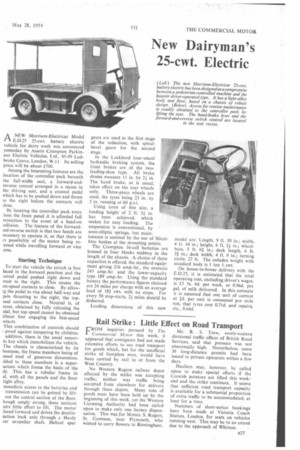New Dairyman's 25-cwt. Electric
Page 61

If you've noticed an error in this article please click here to report it so we can fix it.
A NEW Morrison-Electricar Model
E,D.25 25-cwt. battery electric vehicle for dairy work was announced yesterday by Austin Crompton Parkinson Electric Vehicles, Ltd., 95-99 Ladbroke Grove, London, W.11. Its selling price will be about £700.
Among the interesting features arc the location of the controller pack beneath the full-width seat, a forward-andreverse control arranged in a recess in the driving seat, and a control pedal which has to be pushed down and thrust to the right before the contacts will By locating the controller pack away :rom the front panel it is afforded full )rotection in the event of a head-on ;ollision. The feature of the forwardind-reverse switch is that two hands are iecessary to operate it, so that there is Lo possibility of the motor being re;erscd while travelling forward or vice crsa.
Starting Technique
To start the vehicle the switch is first laced in the forward position and the mtrol pedal pushed right down and mist to the right. This causes the rat-speed contacts to close. By allowig the pedal to rise about half-way and ;ain thrusting to the right, the topLeed contacts close. Neutral is, of )urse, obtained by fully releasing the xlal, but top speed cannot be obtained ithout first engaging the first-speed Intacts.
This combination of controls should proof against tampering by children. addition, there is the usual remov 4c key which immobilizes the vehicle.
The chassis is characterized by its
bustness, the frame members being of essed steel of generous dimensions. 21ded to these members is a superucture which forms the basis of the dy. This has a tubular frame in el, with all the panels and the floor light alloy.
mmediatc access to the batteries and transmission can be gained by liftout the central section of the floor. hough amply strong, these sections uire little effort to lift. The motor laced forward and drives the doubleaction back axle through a Hardy cer propeller shaft. Helical spur gears are used in the first stage of the reduction, with spiralbevel gears for the second stage.
In the Lockheed four-wheel hydraulic braking system, the front brakes are of the twoleading-shoe type. All brake drums measure 11 in. by 2/ in. The hand brake, as is usual, takes effect on the rear wheels only. Three-piece wheels are used, the tyres being 23 in. by 5 in. running at 60 p.s.i.
Using tyres of this size, a loading height of 2 ft. 3-/ in. has been achieved, which makes for easy loading. The suspension is conventional, by semi-elliptic springs, but maintenance is assisted by the use of Silentbloc bushes at the mounting points.
The Crompton 16-cell batteries are housed in four blocks midway in the length of the chassis. A choice of three capacities is offered, the standard equipment giving 216 amp.-hr., the oversize 243 amp.-hr. and the lower-capacity type 189 amp.-hr. Using the standard battery the performance figures claimed are 24 miles per charge with an average load of 181 cwt. with no stops. For every 50 stop-starts, 2. miles should be deducted.
Leading dimensions of this new
model are: Length, 9 ft. 10 in.; width, 4 ft. 10 in.; height, 6 ft. 24 in.; wheelbase, 5 ft. 6/ in.; deck length, 6 ft. 3/ in.; deck width, 4 ft. 9 in.; turning circle, 27 ft. The unladen weight with standard body is 1 ton I cwt.
On house-to-house delivery with the E.D.25, it is estimated that the total operating cost, excluding driver's wages, is £3 5s. 4d. per week, or 0.96d. per gal. of milk delivered. In this estimate it is assumed that one unit of current at Id. per unit is consumed per mile run, that tyres cost 0.7Id. and repairs, etc., 0.64d.




































































































